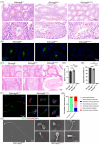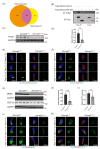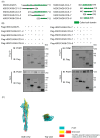Loss of C-Terminal Coiled-Coil Domains in SDCCAG8 Impairs Centriolar Satellites and Causes Defective Sperm Flagellum Biogenesis and Male Fertility
- PMID: 40801568
- PMCID: PMC12346347
- DOI: 10.3390/cells14151135
Loss of C-Terminal Coiled-Coil Domains in SDCCAG8 Impairs Centriolar Satellites and Causes Defective Sperm Flagellum Biogenesis and Male Fertility
Abstract
Sperm flagellum defects are tightly associated with male infertility. Centriolar satellites are small multiprotein complexes that recruit satellite proteins to the centrosome and play an essential role in sperm flagellum biogenesis, but the precise mechanisms underlying this role remain unclear. Serologically defined colon cancer autoantigen protein 8 (SDCCAG8), which encodes a protein containing eight coiled-coil (CC) domains, has been associated with syndromic ciliopathies and male infertility. However, its exact role in male infertility remains undefined. Here, we used an Sdccag8 mutant mouse carrying a CC domains 5-8 truncated mutation (c.1351-1352insG p.E451GfsX467) that models the mutation causing Senior-Løken syndrome (c.1339-1340insG p.E447GfsX463) in humans. The homozygous Sdccag8 mutant mice exhibit male infertility characterized by multiple morphological abnormalities of the flagella (MMAF) and dysmorphic structures in the sperm manchette. A mechanistic study revealed that the SDCCAG8 protein is localized to the manchette and centrosomal region and interacts with PCM1, the scaffold protein of centriolar satellites, through its CC domains 5-7. The absence of the CC domains 5-7 in mutant spermatids destabilizes PCM1, which fails to recruit satellite components such as Bardet-Biedl syndrome 4 (BBS4) and centrosomal protein of 131 kDa (CEP131) to satellites, resulting in defective sperm flagellum biogenesis, as BBS4 and CEP131 are essential to flagellum biogenesis. In conclusion, this study reveals the central role of SDCCAG8 in maintaining centriolar satellite integrity during sperm flagellum biogenesis.
Keywords: MMAF; SDCCAG8; centriolar satellites; male infertility; sperm flagellum biogenesis; spermiogenesis.
Conflict of interest statement
The authors declare no conflicts of interest.
Figures






Similar articles
-
A subset of evolutionarily conserved centriolar satellite core components is crucial for sperm flagellum biogenesis.Theranostics. 2025 Jun 12;15(14):7025-7044. doi: 10.7150/thno.117118. eCollection 2025. Theranostics. 2025. PMID: 40585997 Free PMC article.
-
Prescription of Controlled Substances: Benefits and Risks.2025 Jul 6. In: StatPearls [Internet]. Treasure Island (FL): StatPearls Publishing; 2025 Jan–. 2025 Jul 6. In: StatPearls [Internet]. Treasure Island (FL): StatPearls Publishing; 2025 Jan–. PMID: 30726003 Free Books & Documents.
-
WDR2 regulates the orphan kinesin KIN-G to promote hook complex and Golgi biogenesis in Trypanosoma brucei.mBio. 2025 Jul 9;16(7):e0037125. doi: 10.1128/mbio.00371-25. Epub 2025 May 30. mBio. 2025. PMID: 40444464 Free PMC article.
-
Molecular insights into sperm head shaping and its role in human male fertility.Hum Reprod Update. 2025 Jul 1;31(4):307-332. doi: 10.1093/humupd/dmaf003. Hum Reprod Update. 2025. PMID: 40037590 Review.
-
Improving sperm selection strategies for assisted reproduction through closing the knowledge gap in sperm maturation mechanics.Hum Reprod Open. 2025 Jul 3;2025(3):hoaf040. doi: 10.1093/hropen/hoaf040. eCollection 2025. Hum Reprod Open. 2025. PMID: 40698010 Free PMC article. Review.
References
Grants and funding
LinkOut - more resources
Full Text Sources
Research Materials

